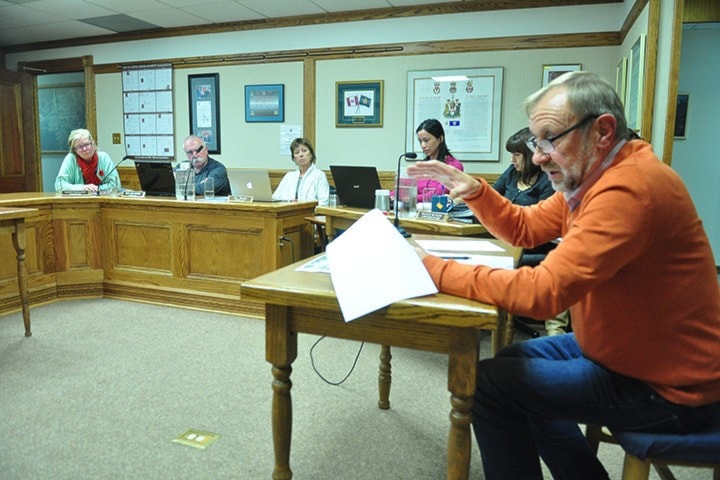A wish list for the Cooke Avenue development has been drawn up, based on the concerns and recommendations of the neighbourhood.
On Monday night a committee of the whole meeting was held to air concerns that arose out of a public meeting in September and discuss the broad strokes of the proposed 20-unit development for the former Cooke Avenue school site.
Council spent over 90 minutes—including around 15 minutes for public comment, and another 10 minutes for the developer Cezary Ksiazek—discussing five major points.
Density, grade/height, traffic/access, design and economics were dealt with, as well as some of the more philosophic issues surrounding a development in a city that has few new structures going up.
Council talked on many of the points the neighbours were concerned about, and the five people who gathered—down from the over 50 who showed up a few weeks ago the last public meeting—noted that.
Several council members did not like the density of the development, and felt it should be lowered, from 20 units to 16. The Official Community Plan directs council to consider higher density developments anywhere in Rossland on a project by project basis.
However, councillor Kathy Wallace felt the units were not affordable.
“I don't think the community is getting (housing stock) diversity out of this development,” she said.
The recommendation that would come to council later this month would include a bonus density incentive that would allow four additional units, each under 50 square metres, to be added in that would not affect the agreed upon density.
Council also passed a recommendation that city staff work with the developer to create a lot grading plan and work with the natural grade of the land.
A city staff recommendation asked to ensure that building height was measured from existing grade, not from fill, and retain the bylaw's 12-metre height.
“This can be done by specifically stating that in the bylaw,” said city planner Stacey Lightbourne. “The applicant is agreeable to this.”
With traffic and access points (driveways) also a community concern, the developer—through discussion with city staff—agreed to ensure there were only two accesses on Cooke Avenue by changing the bylaw to include this restriction.
“This will allay some traffic impact concerns. The developer is agreeable to this restriction,” Lightbourne stated in her report to council.
The design of the development will likely open up a larger question of design principles, seeing as the city itself has no bylaw regulating design. Councillor Kathy Moore said the Cooke development was the opportune time to establish some guidelines for the city.
“This is a very important issue for the community,” she said. “The site is particularly important because it is one of the biggest development areas in the city. I'd really like to see us do something, in a limited way, that puts some design guidelines out there.”
Council agreed to proceed with more specific design guidelines for multifamily developments within the City of Rossland and discuss what it would be during the budget discussions.
“It is possible that the guidelines may be adopted by council prior to the submission of a building permit for this site,” said Lightbourne.
The developer had previously agreed to planting 12 trees on the Cliff Street right-of-way and improving the area following installation of a water main and providing snow storage right of ways along Monita, Cooke and Thompson avenues at the time of development. This will be included in a development agreement.
Staff and the developer have also discussed lane way land swap opportunities to allow for more creative development of the site, read a city staff report. The developer is open to this option so staff will continue to explore this possibility.
For economics, council drafted a recommendation to review the Good Neighbour bylaw to manage the hours of work allowed and dust mitigation.
However, in doing so the changes would have to apply to all developers and contractors in the city, said deputy chief administrative officer Tracey Butler.
Councilor Jill Spearn previously noted that council’s wish list would only be suggestions to the developer, since he ultimately owns the land, and was proposing a development within the bounds of the Official Community Plan with regards to density, height, traffic and other considerations.
But the city must change the zoning of the property for developer Ksiazek on the former school site to allow it to go from P1, public institutional to CD 6, mixed residential.
If council does not pass a rezoning for the site—a denial of the proposal—it would mean the developer must wait another six months before re-applying.
After council reviews the recommendations at their next public meeting the development application will again come before the public in another hearing, before the final vote.
Cezary Ksiazek has been trying to develop the former Cooke Avenue school site since it was purchased by a trio of local investors in early 2011.
The current rezone application first came to light in September, 2011, but it wasn't until Dec. 10, 2012 that a public hearing was held on the project.
The development is slated for two large lots to allow mixed residential on what is public institutional, building a proposed 24 townhouse units in the form of six, four-unit homes facing Thompson Avenue and Cooke Avenue.
Each unit will include three bedrooms, two bathrooms and a single or double car garage. The total living space will be approximately 2,000 square feet and at $150 per square foot, including land cost, it is the lowest possible price, said Ksiazek.
Ksiazek has conducted a preliminary review of servicing requirements for the site—a full city block—and is proposing the multiple-family dwellings within the one-block span on the former Cooke Avenue school site now zoned public institutional.
